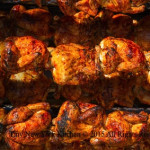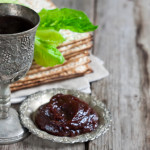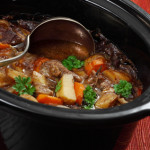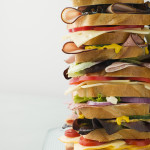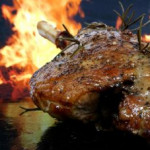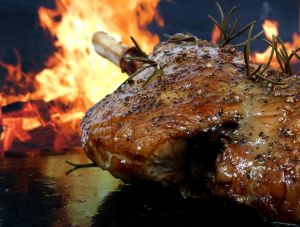Pantry & Freezer Staples
How long do pantry and freezer staples last? Staple items are known for their long shelf life, but they don’t stay fresh forever! Use this handy list to determine how long you should keep them on hand.
Freezer
Hamburger & Stew Meats: Shelf Life: 1 to 2 Days Storage: 3 to 4 Months
Ground Turkey, Veal, Pork, Lamb: Shelf Life: 1 to 2 Days Storage: 3 to 4 Months
Bacon: Shelf Life: 7 Days Storage: 1 Month
Sausage (Raw From Pork, Beef, Chicken or Turkey): Shelf Life: 1 to 2 Days Storage: 1 to 2 Months
Fresh Steaks: Shelf Life: 3 to 5 Days Storage: 6 to 12 Months
Fresh Roasts: Shelf Life: 3 to 5 Days Storage: 4 to 12 Months
Chicken or Turkey (Whole): Shelf Life: 1 to 2 Days Storage: 1 Year
Chicken or Turkey (Cut Up): Shelf Life: 1 to 2 Days Storage: 9 Months
Lean Fish: Shelf Life: 1 to 2 Days Storage: 6 Months
Fatty Fish: Shelf Life: 1 to 2 Days Storage: 2 to 3 Months
Fresh Shrimp, Scallops, Crawfish, Squid: Shelf Life: 1 to 2 Days Storage 3 to 6 Months
Pantry
Baking Powder: Shelf Life: 18 Months Storage: Keep In Dry Place In Airtight Container
Beans (Dried & Uncooked): Shelf Life: 1 Year Storage: Store In Cool & Dry Place
Chocolate (Semisweet & Unsweetened): Shelf Life: 18 Months Storage: Keep In Cool Place
Cocoa: Shelf Life: 1 Year Storage: Keep In Cool Place
Cornstarch: Shelf Life: 18 Months Storage: Store In Airtight Container
Flour (White or Whole Wheat): Shelf Life: 6 to 8 Months Storage: Store In Airtight Container or Freeze To Extend Shelf Life
Nuts (In Shell & Unopened): Shelf Life: 4 Months Storage: Freeze to Extend Shelf Life
Spices & Herbs (Ground): Shelf Life: 6 Months Storage: Store in Airtight Containers In Dry Areas Away From Sunlight & Heat. Before Using, Check Aroma – If Faint Replace.
Sugar (Brown): Shelf Life: 4 Months Storage: Store in Airtight Container
Sugar (Confectioners’): Shelf Life: 18 Months Storage: Store in Airtight Container
Sugar (Granulated): Shelf Life: 2 Years Storage: Store in Airtight Container
Vinegar (Unopened): Shelf Life: 2 Years
“Work With What You Got!”
© Victoria Hart Glavin Tiny New York Kitchen © 2016 All Rights Reserved
Ways To Make The Most Of Seasonal Citrus
Zest It
Add zip to baked goods, stir-fries or stews. Make citrus salt!
Juice It
Lemons juice helps keep sliced fruits and root vegetables from turning brown. Finish savory dishes with a squeeze of lemon juice to enhance the flavors.
Freeze It
Freeze citrus juice or zest until you’re ready to use it.
Dry It
Bake peels on the lowest possible heat until dry, but still pliable. Use to flavor black tea, roasted chicken or braised meats.
Candy It
Garnish desserts and cocktails with candied peels or enjoy them as a sweet snack.
“Work With What You Got!”
© Victoria Hart Glavin Tiny New York Kitchen © 2016 All Rights Reserved
Ways To Use Your Roasted Chicken
Summer is over, the kids are back in school, and it’s back to busy life as usual. Already cooked chicken is a perfect way to save time in the kitchen. Here are some great ways to use roasted chicken for easy weeknight dinners.
Salads: Add to mixed greens, chopped tomatoes, chopped cucumbers, shredded carrots, and sliced red onions. Toss with your favorite low-fat or fat-free dressing.
Lettuce Wraps: Add 2 cups of chopped chicken to shredded carrots, green onions, and bean sprouts. Toss with teriyaki sauce. Spoon onto lettuce leaves and sprinkle with almonds. Fold sides of lettuce over filling and roll up.
Sandwiches & Wraps: Make a chicken salad filling with crunchy celery and apples. Use plain low-fat yogurt and add a touch of curry powder or cumin for dressing. Stuff into a pita pocket or spoon into a wrap and roll up.
Soups: Add 2 cups chopped chicken, your favorite chopped vegetables and 1 cup of uncooked rice or noodles to 6 cups of fat-free chicken broth.
Quesadillas: Combine shredded chicken with a pinch of cumin. Spoon on one half of a flour tortilla. Sprinkle with cheese and fold tortilla in half. Cook on a nonstick skillet for 3 minutes on both sides.
Burritos, Enchiladas, Fajitas & Tacos: Add shredded chicken to salsa, beans, sour cream and cheese. Or combine with sautéed onions & sweet peppers, shredded lettuce & chopped tomatoes, or mix with green chiles, spices, green onions and enchilada sauce. Serve on flour or corn tortillas.
Pasta Dishes: Use shredded chicken instead of ground beef in your favorite lasagna recipe.
Skillet Meals: Add 1 1/2 cups of chopped chicken to sautéed onions, broccoli, mushrooms, and rice. Cook in low-fat broth. Sprinkle on Parmesan cheese before serving.
“Work With What You Got!”
© Victoria Hart Glavin Tiny New York Kitchen © 2015 All Rights Reserved
Slow-Cooker Meat Cuts
It’s winter and there’s nothing quite like coming home to a hot meal. You count on your slow-cooker for delicious, almost no effort dinners and it can be tempting to throw just about any ingredients into these amazing appliances. BUT for the tastiest results, you need to know which meats do best in it. Delivering low, even heat over a long period of time, slow-cookers break down the connective tissue in typically tough cuts of meat, making them extremely tender. Here is a quick guide to great cuts of meat for your slow-cooker. The good news is that these cuts are often less expensive which, along with saving you time and energy, will also save you money.
Beef: Slowly cooked brisket becomes incredibly tender. Look for marbling. The white steaks of fat are what adds flavor. Beef chuck is another favorite for long braises.
Chicken: Go with dark meat. Thighs and drumsticks are cheaper and richer in flavor than white meat and stand out in soups and stews. Brown or remove the skin before cooking for the best results.
Lamb: Cooked low and slow, lamb shanks become rich and complex flavors. Have your butcher slice them crosswise to fit into your slow-cooker. Lamb shoulder is also a great choice for slow-cooking.
Pork: Always a classic, pork shoulder is a tough cut that becomes silky and flavorful after hours spent simmering in its own juices.
For most of us, it’s cold outside so bring out your slow-cooker and let it work its magic while you’re busy doing other things.
"Work With What You Got!"
© Victoria Hart Glavin Tiny New York Kitchen
A sandwich doesn’t have to be full of fat and calories. Replace high-fat mayonnaise with one of the reduced-fat varieties. You may want to stir in some chopped fresh herbs into reduced-fat mayonnaise for a flavor boost. You may also want to hold the mayo and spread your bread with mustard, as mustard is naturally low fat. You may also want to try a spread of non-fat yogurt mixed with a bit of mustard. Chutney, delicious by itself or when blended with mayonnaise or mustard, adds a sweet and spicy dimension to a sandwich.
Many lunch meats are high in sodium and calories. Look for alternatives such as grilled vegetables or skinless chicken breast, roasted turkey breast, or shrimp in a low-fat dressing. Another good alternative is water-packed tuna.
Cheese is a high-fat sandwich ingredient that should be eaten in moderation. Choose lighter cheeses such as Swiss or low-fat cheese.
Rather than ordering your sandwich at the deli counter, take a stroll by the salad bar. There are many candidates for a great sandwich just waiting to be piled onto bread (or into a pita) and drizzled with low-fat dressing.
A few healthy choice ingredients are: artichoke hearts, roasted peppers, pepperoncini, sprouts, shredded carrots, asparagus, sliced tomatoes, and tofu.
"Work With What You Got!"
© Victoria Hart Glavin Tiny New York Kitchen
Labor Day Weekend is the perfect weekend for a picnic. To celebrate the end of summer I’ve organized a feast of some of America’s favorites – from fried chicken to chocolate cake, cheeseburgers to homemade strawberry ice cream.
Parsley Potato Salad
Mushroom Artichoke Salad
Chile-Spiced Bean Salad
Crusty Parmesan Chicken Breasts
Deviled Eggs
Pickled Beets
Barbecued Cheeseburgers
Tomatoes
Radishes
Lettuce
Red Onions
Pickles
Olives
Chocolate Buttercream Cake
Strawberry Ice Cream
Strawberries
Beer
Lemonade
Coffee
Packing the picnic: The salads can be prepared a day in advance. It’s probably not necessary to double the recipes unless you have a large crowd to feed. Be sure to include a serving spoon for each salad. The Crusty Parmesan Chicken Breasts can be served either cold or warm. Either bake it a day ahead, refrigerate it, and carry it in a cooler; or pop it in the oven about an hour before you leave and transport it hot. The deviled eggs can be made from your favorite recipes or one from Tiny New York Kitchen. They will need several hours to chill and must be packed in a cooler, along with the assortment of vegetables (each in a plastic container). Take along a basket or platter for the chicken, a tray for the eggs, and serving forks.
All of the barbecue equipment can travel in a sturdy cardboard box, if there’s room, lay the buns and cheese on top so they don’t get squished. The hamburgers and condiments should be packed in a cooler.
You can bake the cake and prepare the frosting well in advance; both can be stored in the freezer. After thawing, the frosting should be beaten for a few minutes with an electric mixer. A round plastic serving plate with a high, tight-fitting cover is ideal for transporting the cake; remember to carry along a knife and a cake server.
In a cooler, pack the ice cream custard, berry mixture, and ice, each in its own container. Take a hammer and large, heavy dishtowel for crushing the ice cubes, and rock salt for the ice cream freezer (which would be a non-electric one). Pack the fragile ice cream cones and berries for garnish last.
Keep the beer in the cooler. For the lemonade and coffee, you will need a couple of thermoses. Preheat the one for the coffee; don’t forget to take cream (kept cold) and sugar. Pre-chill the other thermos and fill it with cold lemonade.
At the site: Assemble the ice cream freezer and begin hand-cranking, taking turns so that everyone can participate. If the ice cream is ready before it’s time for dessert, remove the dasher, cover the container, and let it stay in the freezer to ripen; don’t forget to dump out the salty water and pack the freezer with fresh ice.
Fire up the barbecue about 30 minutes before you want to begin cooking. Grill the cheeseburgers when the coals are gray. Arrange the chicken in a basket, set out the rest of the food, and dig in.
 Feast of Saint John The Baptist June 24th
Feast of Saint John The Baptist June 24th
One of the many unique things that we could say in describing St. John the Baptist is that he is truly the "Saint of Summer." Saint John the Baptist is one of the most important saints. Other than the Virgin Mary and St. Joseph, John the Baptist is the only saint who is honored on the Church calendar with more than one Feast Day (the other is August 29th, the day of his martyrdom). As we can see, both these Feast Days occur at the opposite ends of the Summer season. John the Baptist saw and lived very clearly his purpose in life and carried it out in the midst of challenges. He had two important qualities of his life that should inspire us each day.These two qualities are humility and a sense of purpose.
Son of Elizabeth and Zacharias, both already advanced in years and childless, John was born about 6 months before Jesus. This birth had been announced by the archangel Gabriel to Zacharias, who was struck dumb by the message. 8 days after the birth, having to be circumcised, the child needed a name, and Zacharias succeeded in writing “John,” following indications of the angel; his tongue loosened in the hymn of the Benedictus. In representations of the birth o the Baptist, Mary is usually also present, assist her cousin Elizabeth, while Zacharias is most often shown in the act of writing. The name John is from a Hebrew name meaning “Yahweh is gracious.”
This is a great feast of June that is common to countries and has been celebrated since early times, is the Nativity of Saint John the Baptist, also known as Midsummer. In lots of places bonfires are lighted in honor of Saint John. This day is to celebrate the summer solstice. In Ireland and in England these bonfires had their origin in the Druidic fires lighted in honor of the god of the sacred wood. Today they are known as the Fires of Saint John although a few pagan customs remain in connection with the celebration.
In France the bonfires are built as close as possible to one of Saint John’s own chapels. It is important to have a boy named Jean or a girl named Jeanne provides a wreath to throw into the fire. When vesper services are over the priest kindles the blaze and the evening begins with singing and dancing which will last far into the night.
In Mexico Saint John’s feast is a big affair. Saint John is the Mexicans dearly beloved saint, especially the saint of the waters. On this day wells and fountains are decorated bright with ribbons and flowers. At midnight on the eve, everyone bathes: in the country in lakes or pools or rivers; in large cities the festivities center around the fashionable bath houses where swimming contests and exhibitions of diving skill take place.
Saint John’s Day in Mexico is definitely also a day of feasting. Everyone brings food to the bathing places. Cakes, sweets, chicken tamales, stuffed peppers, pork tacos and empanadas.



